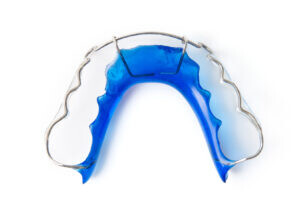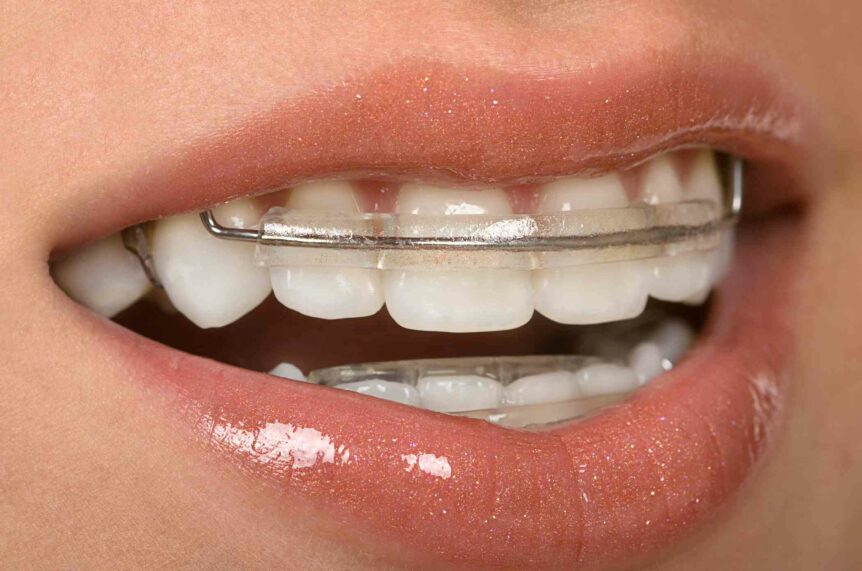What are Retainers?
Retainers are orthodontic appliances that maintain the new position of your teeth after orthodontic treatment. This is because teeth have a tendency to move back into their original positions due to growth-related factors affecting the gums and tissues of the periodontal ligament.
Getting older can also affect teeth movement. Because of this risk, the devices are necessary to ensure teeth stay straight long-term after treatment.
When are Retainers Necessary?
New retainers are custom-made for your upper and lower teeth directly after braces or clear aligner treatment is complete.
After Braces Treatment
Braces are the most common form of fixed orthodontic treatment used to correct misaligned teeth and reposition the jaw. There are a few different types of orthodontic braces, including traditional, clear, and lingual retainers. Although, traditional metal braces are the most effective and affordable treatment option.
After treatment is complete, an orthodontist makes a mold of you or your child’s newly straightened teeth. Then a technician makes a fixed or removable retainer to keep the teeth in alignment.
After Clear Aligner Treatment
Clear aligners (invisible aligners) are removable orthodontic treatments that correct misaligned or crooked teeth. They are a flexible and convenient alternative to braces.
A new set of aligners is sent to your house every 1 to 2 weeks and must be worn for about 22 hours a day. Similar to braces, retainers are custom-made for each patient after treatment is complete to keep the teeth in alignment.
What is Relapse and Retention?
Relapse refers to the partial or full return of pre-treatment malocclusion (teeth misalignment) following successful orthodontic treatment.
Depending on the patient, maintaining teeth in their corrected locations after treatment can be very difficult. If the devices aren’t worn properly or for the right amount of time each day, relapse can occur over time.
Your orthodontist will discuss the “retention” phase before treatment begins. Retention refers to the phase of orthodontic treatment that minimizes the risk of tooth movement and misalignment following the removal of clear aligners or braces.
Gathering this information early on helps the orthodontist decide on the best retainer for the patient’s needs.
If your child’s teeth were severely misaligned before orthodontic treatment, a small amount of “relapse” commonly occurs. This is normal and typically nothing to worry about because minor relapse does not affect the overall aesthetic improvement.
If only mild misalignment was present before treatment, relapse should not occur. Patients should also be made aware of their relapse risk before treatment.
How Many Types of Retainers are There?
There are a few different types of retainers available, including fixed (metal) and removable (clear) retainers. The type of retainer needed depends on the patient’s risk of relapse, original malocclusion (teeth misalignment), and growth pattern.
How long an orthodontic retainer must be used is different for everyone. However, the only way to guarantee teeth positioning is to wear a retainer indefinitely.
1. Fixed Retainers
Fixed retainers consist of a metal wire that is cemented to the back of your front teeth. The wire typically extends from canine to canine.
You cannot remove fixed retainers at home. Only your orthodontist can remove the device in-office. Also, fixed retainers do not affect eating or speaking abilities. After a few days of wear, you should not be able to feel it.
Orthodontists usually give patients back-up removable retainers in case the fixed retainers fail or if you have a high risk for relapse (when the teeth move back into their original position before treatment).
2. Removable Retainers
Removable retainers are clear or metal appliances that only need to be worn at night. Unlike fixed appliances, you can remove these retainers at any time.
Removable retainers are easy to maintain and do not impact oral your oral health as they can be removed and you can use your normal toothbrush, toothpaste, and floss. Although, they do affect speaking abilities when in use. You should also remove the device before eating.
Clear retainers are the best option for patients who can wear a retainer part-time and do not have a high risk for relapse.
Types of Removable Retainers
There are three different types of removable retainers, including:
Hawley Retainers
Hawley Retainers, also called wire retainers, consist of a metal wire and an acrylic base. These retainers keep the six anterior teeth in the correct position after orthodontic treatment.
Hawley retainers do not interfere with your natural tooth contact and are often more comfortable than clear retainers.

Essix Retainers
Essix Retainers, also called clear retainers, are made of a slim, clear plastic material. These retainers hold the teeth in place after clear aligner treatment or braces.
Clear retainers can cause more discomfort than Hawley (metal) retainers because your teeth will not touch naturally.

A Vivera retainer is another type of clear retainer that holds the teeth in place after Invisalign treatment. This retainer is made exclusively for Invisalign patients.
Which Retainer is More Expensive?
The average cost of orthodontic retainers:
- Hawley retainers cost $150-$300 for one or up to $600 per set
- Essix retainers cost $125-$300 for one or up to $500 per set
- Vivera (Invisalign) retainers can cost as low as $660 for four sets
- Permanent (bonded) retainers cost $150-$500 for one or up to $1,000 per set. However, bonded retainers are usually included in the price of treatment if done at an orthodontist’s office.
Retainers FAQs
Do you have to wear a retainer forever?
How long an orthodontic retainer must be worn is different for everyone. However, the only way to guarantee teeth positioning is to wear a retainer at least part-time for the rest of your life.
Are clear or metal retainers better?
Clear retainers can cause more discomfort than Hawley (metal) retainers because your teeth will not touch naturally. Hawley retainers do not interfere with your natural tooth contact and are often more comfortable. Both types of retainers can interfere with speaking abilities when in use and must be removed for eating and cleaning.
Permanent retainers cannot be felt or seen and do not disrupt eating or speaking abilities. However, they are prone to plaque buildup over time and can affect your oral hygeine without regular brushing and flossing.
How long do clear retainers last?
Clear plastic retainers need to be replaced every 2 to 6 years, while metal (Hawley) retainers can last 5 to 10 years. Permanent retainers can last up to 20 years with proper care.
Read more about Clear Aligners

